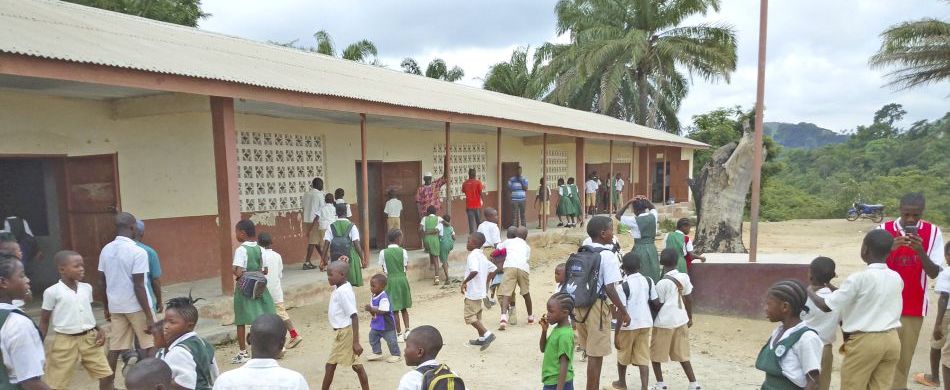Kolahun Rising
DURING Liberia’s long civil war, which raged from 1989 to 2003, the land and population were devastated, putting the development of the country back by as much as 50 years. It remains among the poorest countries in the world.
Kolahun district, part of Lofa County, has a population of nearly 100,000, predominantly from the Bandi ethnic group, with a Muslim majority and a small Christian minority. Poverty is widespread, and 54 percent of children do not complete primary school due largely to economic difficulties.
The Catholic School of Kolahun, dedicated to Saint Agnes, was established in the early 1980s. It quickly became a center of excellence, and was one of the best junior high schools in the district. Unfortunately, during the civil war, it was completely destroyed, leaving only the foundations, along with the memories of former students.
“St. Agnes School experienced a rebirth in 2015 through the initiative of a catechist, Nyuma Sontay,” explains Fr. Lorenzo Snider, project manager. Fr. Snider is parish priest of Foya and a resident at Saint John Vianney Parish; he is also a missionary of the Society of African Missions (SMA). “At that time, lessons were held under a makeshift shelter and in a large hall also used as a church.” But in 2019 the Bishop of Gbarnga encouraged the building of six classrooms. “Two years later, the diocese asked me to manage the school as supervisor,” Fr. Lorenzo continues. “We achieved our first goal: to complete the sixth grade of elementary school with a certain level of stability while maintaining good teaching standards.” Enrolments grew, and by 2024 the school had 174 students guided by 10 teachers. Many students face severe financial hardship and are supported through scholarships.
€24,300 granted
The ambition of the parents and teachers is to extend the school to junior high level so that children can continue to Grade 9 locally, instead of being forced to stop studying or travel far from home. But to do this, more classrooms were urgently needed.
“We asked St. Anthony’s Charities for financial help in the construction of three classrooms and a library/study hall,” says Fr. Lorenzo. His request was simple but vital: without new facilities, the school’s growth would stall, and the fragile progress made since the war could be lost.
The project was prepared by the parish in collaboration with the Diocese of Gbarnga and the Catholic Schools’ Secretariat. The Society of African Missions (SMA), entrusted with pastoral and educational responsibility in the region under a long-term agreement with the Diocese, ensures continuity and stability for such initiatives. The parish offered the land. Parents pledged unskilled labor. The school administration contributed about €460 from its budget, and former students promised desks, benches, and tables. SMA benefactors donated €12,500. But this still left a large gap: the total cost was €36,800. The remaining €24,300 was agreed to by St. Anthony’s Charities to fund the project in full.
Permanent structure
With the first instalment received in October 2024, work began immediately. Parents and parishioners cleared the site, removing trees and brush. Foundations were dug entirely by hand. Bricks were made on site using sand and cement. “The material was purchased locally, and local participation was excellent, especially from the parents of the students,” says Fr. Lorenzo.
Once the base was ready, the speed of progress exceeded all expectations. Local carpenters prepared the timber for the roof, while corrugated sheets for covering were purchased in advance. “The work capacity of the building company and the important participation of the population meant the work was faster than expected,” explains Fr. Lorenzo. So much so that the walls began to rise already at the beginning of December, ahead of schedule.
By the end of March 2025, the painting was completed. Afterwards, benches and desks were built from local wood, shelves and tables were added to the study hall, chairs provided for the reading area, and a first set of books purchased to begin a modest library.
The process was not without minor difficulties. “The only drawback was the slow operation of the groups of former pupils, which we made up for with greater participation from the parish,” says Fr. Lorenzo. But apart from this, the work proceeded smoothly.
What mattered most was the commitment of the community itself. “The contribution of the local population, the parents of the pupils, the Christian community, as well as the professionalism of the company, were very positive, and this allowed us to complete the work earlier than expected,” says Fr. Lorenzo. Parents, teachers, parishioners and benefactors each offered what they could. The result is a permanent structure of three new classrooms and a study hall that will serve Kolahun for generations to come.
Tangible benefits
The benefits are already tangible. Children study in classrooms free from the dust, noise and distraction of temporary spaces. Lessons are now calmer and more focused. Teachers can work with greater confidence. Parents are proud to see their children in safe, solid classrooms. The success of the project has reinforced the school’s financial independence and opened the way for expansion. Documentation has already been submitted to establish junior high classes, and nearly all the teachers have agreed to participate in ongoing training next year to raise standards further.
For a district still scarred by war, the project has had a unifying effect. It has shown that even a community with few resources can achieve something remarkable when it works together and when it receives solidarity from outside. The impact goes beyond the classrooms: it strengthens the confidence of parents in the school, encourages more enrolments, and shows young people that education is worth pursuing.
“Thanks again to St. Anthony’s Charities and to the readers of the Messenger of Saint Anthony for the support, the friendship and shared vision in the service of the most abandoned,” concludes Fr. Lorenzo.



